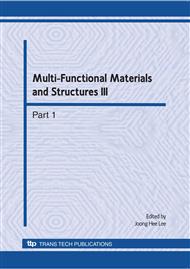p.931
p.935
p.939
p.943
p.947
p.951
p.955
p.959
p.963
Design and Comparison of Three Kinds of Structures for Fabric Keyboard Switch
Abstract:
Flexible fabric keyboard is a field of smart textile. It can overcome traditional horniness keyboard can’t be foldable and washing. Because conventional keyboard’s switch is matrix circuit, two conductive layers are not touchable due to action of a middle insulating layer in relaxing. When the key is pressed, two conductive layers contact and form electric current. In this laboratory study there are three kinds of structure designed such as through-thickness angle interlock, trapezia and X shape structure which consist of the support part and the orifice part. Conductive filaments are 8 roots for the warp and weft conductive material. Then the weaving time, elastic modulus and connection pressure are tested and analyzed for every kind of fabric keyboard switch. It is concluded that the weaving time of through-thickness angle interlock is the shortest and the elastic modulus of X shape structure is the best, but connection pressure of three kinds of structures is all big. These findings may assist in recommendations regarding the further development of flexible fabric keyboard.
Info:
Periodical:
Pages:
947-950
Citation:
Online since:
August 2010
Authors:
Price:
Сopyright:
© 2010 Trans Tech Publications Ltd. All Rights Reserved
Share:
Citation:


